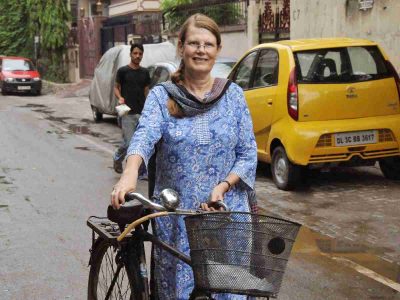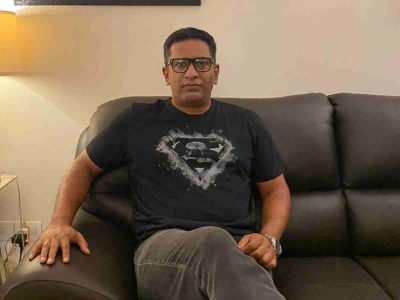He can see a honey bee in a rusted, broken lock, a monkey in a wrench and hair strand in a wire. He welds them together, contours them piece by piece and creates humans, robots, throne, animals, birds, butterflies, insects, stilettos, flip-flops, smart clutches, hats, turban, scarves, and much more.
At times, his robotic ‘Camera Man’ becomes the subject of amusement at Museo Camera, India’s only museum of camera in Gurugram, or his massive eagle with spread wings welcomes you at Gurugram’s highest point, or an elephantine Tau jee, or an enormous eagle-owl at Pune which was created to mark the entry of rare species of eagle-owl on Indian skies after a long gap, signifying decrease in air pollution.
At other times, in his ‘Decoding Patriarchy’ show in Delhi’s India Habit Centre, a young boy riding on Enfield Motorbike, sporting gen-next way of dressing up – transparent yellow shirt and jeans becomes a selfie-gen’s delight. His tribute to Lata Mangeshkar at Poddar Road, Birds of Aravalli, Mammoth sculpture for recent G-20 meet and much more define his skills.
These are a few inches to 30-feet tall and wide installations created with rusted, corroded, deliberately unpainted metal scraps, to signify that junk can be utilised in such artistic ways. They ornate art fairs, museums, or public places such as malls and parks like Garden of Five Senses, five-star hotels, or the highest city point, thus reducing trash causing environmental hazards in Delhi/NCR and other cities of the country.
Meet Gopal Namjoshi, a muralist, painter and sculptor, largely known for crafting these sculptures.
Any artist’s journey is never about what he makes. But what he is made of: his upbringing, his temperament, his habits, the main ingredients of his thoughts, focus and vision. Unlike his creations, his personal artistic journey is not known. Here is an account of the same.
Artistic Journey
For any boy of his age, Gopal was different. Always an introvert, he would never mingle with students and teachers in school/college who had a bitter tongue or who had no interest in books, music, poetry and other arts. Son of a bureaucrat father and homemaker mother – both voracious readers, he always saw his home full of English and Hindi novels and magazines like Illustrated Weekly of India, Sarika, Kadambini, Parag among others.
The open atmosphere trained his senses for classical music, fine Urdu poetry and literature. At 14, he was taken to hear ghazal singer (late) Mehdi Hasan. While others were getting up between the performance to fill their glasses at the bar, Gopal was taught aadab-e-mehfil (etiquettes) — not to get up while the show is on.
So, by the time he was 17, he had found his vocabulary – art, and not commerce that was usually the most sought-after course followed by a job.
“I told my father that I wanted to do arts – make paintings to begin with. He said, ‘Go ahead. Buy colours and start. But remember, you will forever be struggling to make both ends meet. If you have decided, and then prove your worth in it!’”
It affected Gopal in two ways: instilled the uncertainty of future and a challenge to excel. As he reached college (name withheld) he was in for a shock. Those who couldn’t get admission anywhere, were there, most for fun reasons.
“Teachers and students didn’t know how to talk and behave. They were highly stylised in attitude, unlike an artist at heart who is warm and simple. I didn’t want to study in such an atmosphere. I decided to go for safe option — gradation in graduation, followed by a job.”
Until a senior faculty from MS School of Art, Vadodra visited his college.
“She told me, ‘You are good, so you would be good at commerce too. But then you will do a job for eight hours that you don’t like. You won’t be able to answer your passion or rarely. If you continue with your passion, and take it as your profession, never a day would feel like you had worked. It’s the choice of a lifetime. So you decide!’”
Gopal, close to 70 now, thanks her for his fabulous artistic journey today.
Wearing several hats
Gopal was not a sculptor at the beginning. He was a painter and a designer, having keen interest in architectural designs.
Exploring is an artist’s first necessity. Gopal hopped from one architectural marvel to another in Jaipur, Indore, Khajuraho and to Keradu temple, on Pakistan’s Border from Rajasthan to satisfy inner designer in him. The wonders that filled his eyes and mind said, “We can’t even have an iota of vision and depth our ancestors had.”
So he constructed a studio with haystack and mud at Jaipur, his birth-place, to meditate and work. For years it remained a hub for intellectuals, artists, village seniors full of wisdom and legendary poets like Qateel Shifai and ghazal singers like Ghulam Ali who would visit it on their trip to Jaipur for a meaningful gathering.
Of struggle and triumph
Done with the hometown, Gopal soon made Delhi his home in early 2000.
“Those days, art galleries in Delhi were not evolved. They would accept only oil paintings. For them art-works in other medium was craft! Gallerists would tell me, ‘Yahan framed art chalta hai (we take only framed works here)’. But I refused to do so.”
Instead, he created colossal murals from wood, painted them with mixed media and acrylic. Amid a volley of oils everywhere, his unique mural became an instant hit. And he “installed over 140 of them in India and abroad”. Delhi had witnessed a new show-stopper.
He recalls, laughing, “I had turned a huge wooden (scrap) trunk into artistic and utility item in 1994. People could sit on it while enjoying its uniqueness. In the world of fashion, it came 25 years later.”
India is largely known for its riot of colours on canvases and other medium, so Gopal’s light-hued abstract on canvas and mural was a refreshing change for art lovers in Mumbai followed by foreigners who instantly picked his works.
As any creative person, done with murals, Gopal decided to change from murals at the peak of his success. That’s how metal scraps made way in his life.
It began with a well-known architect Rajiv Aggarwal contacting him. “He said that he was working on Damdama Lake at Sohna. He wanted a huge green work of art at the lake that could mingle with the greenery and the water around.”
This was the first time Gopal decided he would create an animal at the lake-side to mingle with flora and fauna around. This time, he thought to experiment with metal scrap to spread a message of environment protection.
Soon, sackfuls of rusted, broken, tarnished, damaged nut, bolt, wires, locks, spare parts of several vehicles, metal washers, sheets, mesh and chains made way to his studio.
Soon, he became a kabadiwala’s delight.
Gopal is now a kababdiwalas’ favourite hunt in Delhi, Gurgaon, Jaipur, Rajasthan, Chandigarh, Pune, Vadodra and other parts of the country.
“Log kehte they, ye pagal hai kya? Aur main sochta thaa, ye pagal hain kya? Inhe kab samajh aayega ki art sirf entertainment ke liye nahi hota, cause ke liye bhi hota hai (People would say, is he mad? And I would laugh at them thinking, ‘are they mad, that they can’t see that art is not just for entertainment but causes too’?).” And he laughs vigorously.
Fun with scrap
He explains the fun of playing with kabaad (scrap).
“When I am saying I am up-cycling it, I don’t mean I want to change the real look of the scrap I am using. Because every scrap has its own character, I don’t damage that. That’s how I could create a fly out of a lock and titled it, “lock can fly”, a smiling monkey from a floppy and so on. I put minimum energy, minimum scratching, rubbing and welding.
“Initially I was not aware that while making such sculptures, fixing and piercing nails and welding needed gloves. I burnt and cut my hands many times like a novice in the kitchen,” he giggles.
With experience, now he knows the exact dimensions of a work. He mostly doesn’t draw geometrical designs, just starts creating.
So, whenever you pass by Saket Mall, watch out for the mammoth horses, the tall and wisdom-full ‘Tau’ at Gurugram, or 1200 kilo, 18-feet Eagle Owl at Pune, or a metal honey bee at any art fair or public space, remember these are created by Gopal Namjoshi to tell you that if insects, bees, birds and animals don’t exist because of hazardous metal scrap landfills or other environmental pollutions, we would be the next casualty.
On a parting note, Gopal dreamily shares, “My Tau jee (paternal uncle) is an Indian wisdom man. Now I shall make Tayi jee to embody an Indian woman in a sari.”
He is looking for funds to bring the couple together.





